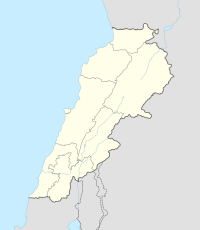Ain Aata
Ain Aata
Ain Ata, 'Ain 'Ata, Ayn Aata | |
|---|---|
Village | |
| Country | |
| Governorate | Beqaa Governorate |
| District | Rashaya District |
| Area | |
| • Total | 22.40 sq mi (58.02 km2) |
| Elevation | 4,360 ft (1,330 m) |
| Population | |
| • Total | around 4,000 |
 Cedars, in the hills of Ain Aata (2 June 1860)[1] | |
| Alternative name | Ain Aata, 'Ain 'Ata, Ayn Aata |
|---|---|
| Location | 99 kilometres (62 mi) east of Beirut |
| Region | Rashaya |
| Coordinates | 33°26′11″N 35°46′46″E / 33.436390°N 35.779446°E |
| History | |
| Cultures | Roman |
| Site notes | |
| Public access | Yes |
Ain Aata, Ain Ata, 'Ain 'Ata or Ayn Aata is a village and municipality situated southwest of Rashaya, 99 kilometres (62 mi) south-east of Beirut, in the Rashaya District of the Beqaa Governorate in Lebanon.[2]
The name is thought to mean "gift spring".[3] There is a remarkably cold spring in the area.[1]
History
In 1838, Eli Smith noted 'Ain 'Ata's population as being Druze and "Greek" Christians.[4] By 2014, Druze residents made up 88.52% of the 1,795 registered voters, with almost all the remainder being Orthodox Christians.[5]
Roman temple
Recent epigraphic surveys have confirmed the ruins of a Roman temple and cult site in the village that are included in the group of Temples of Mount Hermon.[6][7][8][9]
See also
Lua error in mw.title.lua at line 346: bad argument #2 to 'title.new' (unrecognized namespace name 'Portal').
References
- ^ 1.0 1.1 Harvey, 1861, p. 145 ff
- ^ Kitto, 2003, p. 344–
- ^ Royal Geographical Society (Great Britain), 1837, p. 98–
- ^ Robinson and Smith, 1841, vol 3, 2nd appendix, p. 138
- ^ "التوزيع حسب المذاهب للناخبين/ناخبات في بلدة عين عطا، قضاء راشيا محافظة البقاع في لبنان" [Distribution of voters by sect in the town of Ain Atta, Rashaya District, Bekaa Governorate, Lebanon]. Lub-Anan.com. 2014. Retrieved 23 September 2024.
- ^ Kaizer, 2012, p. 76 ff
- ^ Mouterde, 1951–1952, pp. 19–89
- ^ Robinson and Smith, 1857, p. 438 ff
- ^ Stanley, 1871, p. 408 ff
Bibliography
- Harvey, Annie Jane (1861). Our Cruise in the Claymore, with a Visit to Damascus and the Lebanon. Elibron.com. p. 145. ISBN 978-1-4021-3492-0.
- Kaizer, Ted (2008). Aliquot, Julien., Sanctuaries and villages on Mount Hermon in the Roman period in The Variety of Local Religious Life in the Near East in the Hellenistic and Roman Periods. BRILL. p. 76. ISBN 978-90-04-16735-3.
- Mouterde, R. (1951–1952). "Antiquités de l'Hermon et de la Beqâ". Mélanges de l'Université St. Joseph. 29: 19–89. doi:10.3406/mefao.1951.1033. S2CID 239122864.
- Robinson, E.; Smith, E. (1841). Biblical Researches in Palestine, Mount Sinai and Arabia Petraea: A Journal of Travels in the year 1838. Vol. 3. Boston: Crocker & Brewster.
- Robinson, E.; Smith, E. (1857). Later Biblical researches in Palestine, and in the adjacent regions: a journal of travels in the year 1852. Crocker and Brewster. p. 438.
- Royal Geographical Society (Great Britain) (1837). The journal of the Royal Geographical Society of London. J. Murray. p. 98.
- Stanley, A.P. (1871). Sinai and Palestine: in connection with their history. J. Murray. pp. 408–. Retrieved 22 September 2012.
External links
- Pages with non-numeric formatnum arguments
- Short description with empty Wikidata description
- Pages using infobox settlement with no map
- Pages using infobox settlement with no coordinates
- Populated places in Rashaya District
- Archaeological sites in Lebanon
- Ancient Roman temples
- Roman sites in Lebanon
- Tourist attractions in Lebanon
- Druze communities in Lebanon
- Eastern Orthodox Christian communities in Lebanon

